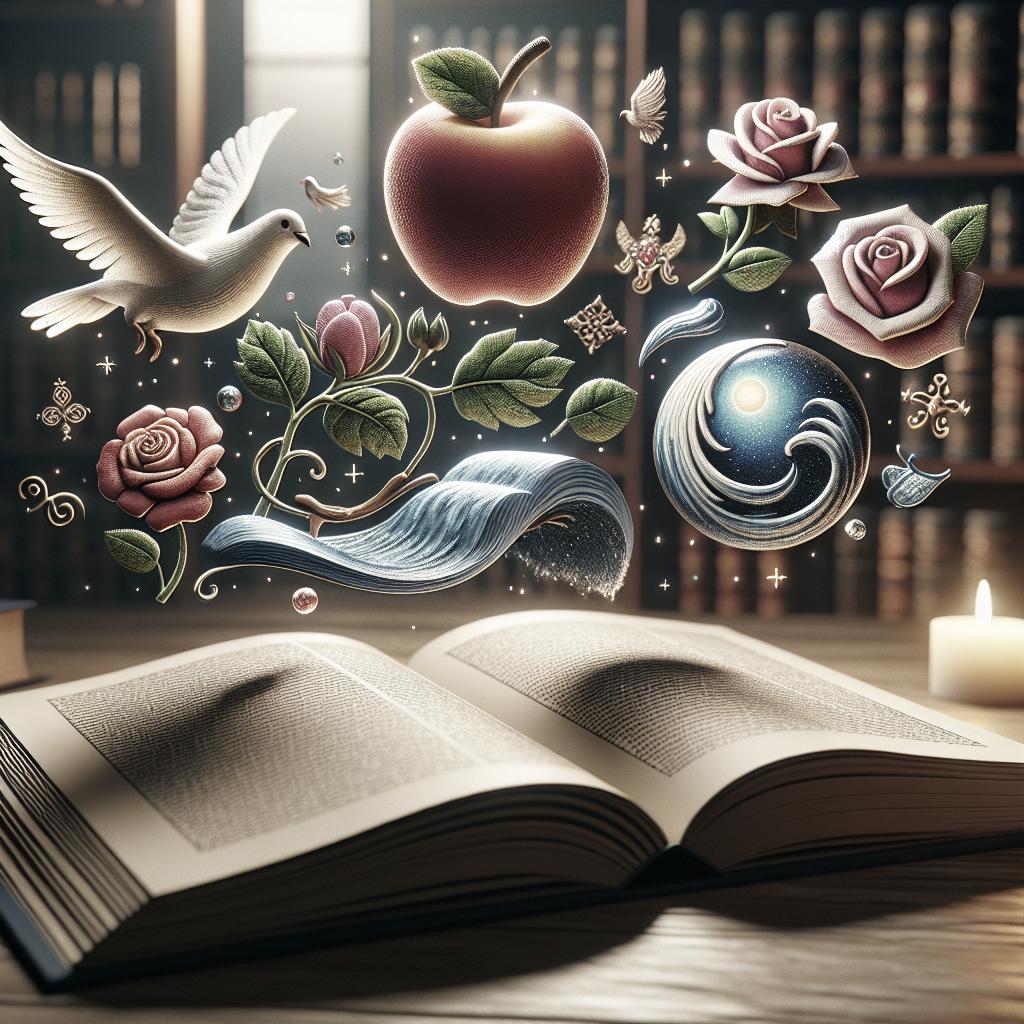Understanding Symbols: A Journey Through Literature Symbolism is a literary device that breathes life and meaning into texts through the use of symbols—objects, characters, or figures that stand for more than their literal sense. Authors and poets weave these elements throughout their works to evoke emotions, convey ideas, and create deeper layers of meaning. In this blog post, we’ll explore the rich tapestry of symbolism in literature, dissecting its definition, identifying common types, and examining some poignant examples. We will also discuss why such symbolism is fundamental in writing and explore related literary terms like allegory, motif, and metaphor. By understanding and utilizing symbolism, writers can enrich their narratives, while readers can gain a heightened appreciation of the texts they engage with. Let’s embark on this exploration and see how symbolism serves as a bridge between the writer’s intent and the audience’s perception. ### Symbolism Definition In literature, symbolism refers to the use of an object, person, idea, or action that stands for something beyond its literal meaning. It’s often utilized to give a more profound meaning to a work and invite readers to look beyond the surface. These symbols can be straightforward or intricately complex, imbued with cultural, emotional, or philosophical weight. Symbols serve as a conduit for authors to infuse their narratives with layered meanings, enhancing the reader’s experience by encouraging interpretation and introspection. Through symbolism, writers provide readers with clues that lead to a greater understanding of the narrative’s underlying themes and messages. Instead of stating things explicitly, authors rely on symbolism to provoke thought and emotional engagement, making the reading experience both interactive and immersive. Recognizing and interpreting symbols transforms the act of reading into a detective-like exploration where each element could be a piece of the puzzle, contributing to a richer understanding of the entire work. ### Common Types of Symbolism in Literature #### 1. Religious Religious symbolism serves as a powerful tool in literature, drawing upon motifs from various faith traditions to add depth to narratives. Biblical symbols, for instance, permeate Western literature, where characters, objects, or events carry connotations of faith, morality, or spiritual struggle. The cross, the serpent, and the apple are common symbols laden with religious significance, often used to parallel accounts of sacrifice, temptation, or redemption. Beyond Christianity, literature is rich with symbols from various religions, such as the lotus in Buddhism, signifying purity and spiritual enlightenment, or the crescent moon and star in Islam, representing faith and guidance. By weaving these religious symbols into narratives, authors not only enrich their stories but also invite discussions on faith, ethics, and human existence, prompting readers to explore deeper truths. #### 2. Romantic Romantic symbolism encapsulates the essence of love, desire, and longing, using a variety of symbols to depict these emotions. Roses, often symbolizing love and beauty, are frequently used to convey romance and passion in literature. Similarly, the heart represents affection and emotion, often acting as a shorthand for expressing deep feelings that transcend words. Symbols of romanticism extend beyond floral and anatomical symbols to include moonlit nights, secluded gardens, and soulful music, all of which evoke an atmosphere of intimacy and connection. These elements often serve to highlight the emotional complexity of characters’ relationships, inviting readers to empathize with their joys and struggles in love. #### 3. Emotional Emotional symbolism taps into the intricate web of human emotions, using symbols to express psychological states or emotional journeys. Weather phenomena like thunderstorms can represent turmoil or conflict, while sunshine might connote hope, clarity, or joy. Colors also play a significant role, with blue symbolizing calmness or melancholy, and red often denoting anger, passion, or danger. Authors use these symbols to externalize internal states, providing readers with insights into characters’ emotions and personal growth. By aligning weather, color, or objects with emotional experiences, writers can create an emotional resonance, allowing readers to feel the characters’ joys and sorrows as if they were their own. ### 20 Examples of Symbolism That’ll Enrich Your Writing #### Symbolism Examples in Literature 1. In F. Scott Fitzgerald’s “The Great Gatsby,” the green light across the bay symbolizes Gatsby’s unreachable dreams and the American Dream itself. 2. Harper Lee’s “To Kill a Mockingbird” uses the mockingbird as a symbol of innocence and the importance of protecting those who are vulnerable. 3. In Herman Melville’s “Moby-Dick,” the white whale symbolizes the immense, ungraspable nature of obsession and the unknown. #### Symbolism Examples in Poetry 1. In Robert Frost’s “The Road Not Taken,” the fork in the road is a classic symbol for life’s choices and the paths we choose. 2. Emily Dickinson frequently uses the symbol of the bird to represent hope and the soul, providing a delicate yet powerful image of resilience. 3. The raven in Edgar Allan Poe’s “The Raven” symbolizes death and his own descent into madness and loss. #### Symbolism Examples in Movies 1. The red balloon in “The Red Balloon” represents innocence, freedom, and the fleeting nature of happiness. 2. In “The Matrix,” the blue and red pills symbolize the choice between the blissful ignorance of illusion (blue) and the sometimes painful truth of reality (red). 3. In “Inception,” the spinning top acts as a symbol of reality versus dreams, determining what is real and what is imagined. #### Symbolism Examples in Everyday Life and Language 1. Black cats are often symbolic of superstition and bad luck in Western cultures, while in some cultures, they are a sign of good luck. 2. Chains can symbolize various concepts, from oppression and confinement to strength and unity, depending on their context. 3. The use of the phoenix in language symbolizes rebirth and renewal, a powerful image of overcoming adversity. ### Why is Symbolism Important in Writing? Symbolism is an essential tool in the writer’s arsenal, as it adds layers of meaning and depth to narratives. It encourages readers to think critically and engage with the text on a deeper level. Instead of consuming content passively, readers become active participants, piecing together symbols to glean insights into the story’s larger themes and messages. Symbols allow for subtlety and nuance, offering writers a way to convey complex emotions or ideas without explicit explanation. This subtlety can enhance character development, plot progression, and thematic expression, making stories more resonant and memorable. Ultimately, symbolism enriches both writing and reading, providing a rich landscape of interpretation and meaning. ### Related Terms #### Allegory An allegory is a narrative in which characters, events, and details serve as symbols that collectively convey a moral, political, or spiritual message. Unlike mere symbolism, which can be isolated to certain aspects, allegory encompasses the entire story, embedding its purpose within the text itself. Classic examples include George Orwell’s “Animal Farm,” where the narrative of farm animals serves as an allegory for the Russian Revolution and its aftermath. #### Motif A motif is a recurring element in a piece of literature that has symbolic significance. It differs from symbolism in that motifs are consistently repeated throughout a work to reinforce and illuminate the themes or central ideas. For instance, in Shakespeare’s “Macbeth,” the motif of blood recurs throughout the play, highlighting themes of guilt and corruption. #### Metaphor A metaphor is a figure of speech that identifies one thing as being the same as some unrelated thing for rhetorical effect, therefore highlighting similarities. It goes beyond symbolism by creating a direct comparison, suggesting that one thing embodies the qualities of another. “Time is a thief” is a classic metaphor that conveys the subtle act of losing time as if it were being taken without our knowledge. ### Using Symbolism Examples to Enrich Your Writing and Understanding Incorporating symbolism into your writing demands creativity and awareness of the universal meanings of symbols. Consider the themes, emotions, and messages you aim to convey and select symbols that naturally align with these elements. Symbols should serve the narrative, seamlessly integrating into the story to support the depiction of characters, settings, and significant events. To enhance your understanding and interpretation, critically analyze the use of symbols in the texts you read. Reflect on how symbols contribute to the narrative’s depth and your emotional response to the work. Over time, recognizing and employing symbolism will become an instinctive aspect of your reading and writing repertoire, deepening your engagement with literature and storytelling. Final Thoughts Symbolism is a multifaceted literary device that enriches both reading and writing experiences. From religious iconography to romantic and emotional symbolisms, the power of symbols lies in their ability to communicate complex ideas succinctly and effectively. Familiarity with symbolism not only aids in crafting layered narratives but also enhances the pleasure and understanding derived from literature, poetry, and even everyday discourse. Here’s a summary table that captures the essence of this discussion: | Aspect | Description | |——————————————–|——————————————————————–| | Symbolism Definition | Use of elements to signify ideas beyond their literal meaning. | | Common Types | Religious, romantic, emotional. | | Symbolism in Literature | Examples: “The Great Gatsby,” “Moby-Dick.” | | Symbolism in Poetry | Examples: Robert Frost, Emily Dickinson. | | Symbolism in Movies | Examples: “The Matrix,” “Inception.” | | Symbolism in Everyday Life | Common symbols like black cats and phoenix. | | Importance in Writing | Adds depth and engages readers in active interpretation. | | Related Terms | Allegory, motif, metaphor. | | Enriching Writing | Integrating symbolism thoughtfully to enhance narrative depth. | By delving deeper into the world of symbols, you open yourself up to a richer understanding of both writing creatively and exploring the intricate layers of human thought and culture embedded in literature.
Decoding the Language of Symbols: Common Themes in Literature


